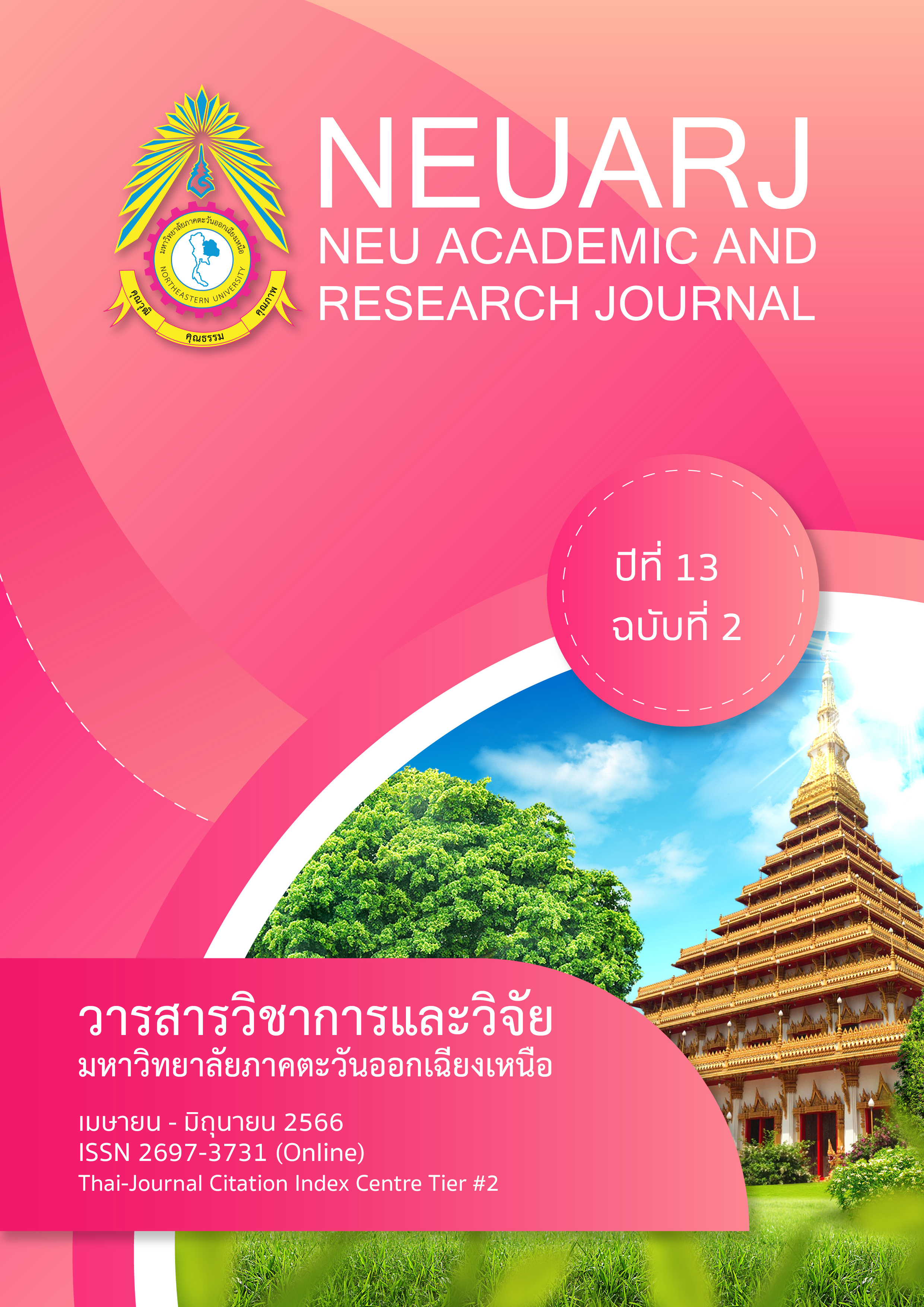Factors of Technology Acceptance Influencing Decision Making on D.DOPA Digital ID System Via Smartphone of User in Udonthani Province.
Keywords:
Factors of Technology Acceptance, Decision Making, D.DOPA Digital ID SystemAbstract
The purpose of this research was to study the factors of technology acceptance that influence decision-making on service usage of digital authentication and verification (D.DOPA Digital ID) via smartphone of users in Udonthani province. This was a quantitative study; quantitative data were collected by using questionnaires as a tool to collect data from 400 samples in Udonthani province. The statistics were used to analyze the data were frequency, percentage, mean, standard deviation, and testing of hypothesis by multiple regression analysis.
The research results were found that technology adoption factors in overall influenced the decision to use the digital identity verification and verification system via smartphone (β = .905) with statistical significance at 0.05. and when testing the influence of technology acceptance factors on the decision to use the service of digital identity verification and verification (D.DOPA Digital ID) via smartphones in each aspect, it was found that : the reliability of the system had the most influence on the decision to use the Digital Authentication and Authentication System (D.DOPA Digital ID) (β = .887), followed by perceived value from services (β = .868), system facilitation (β = .860), social influence (β = .857), the performance expectations (β = .824), the price value (β = .812), and the least influential aspect was effort expectations (β = .795)
References
กรมการปกครอง กระทรวงมหาดไทย. (2564). D.DOPA โครงการพัฒนาระบบการพิสูจน์และยืนยันตัวตนทางดิจิทัล. สืบค้นเมื่อ 12 ธันวาคม 2565, จาก https://www.bora.dopa.go.th/images/snbt/book/63 /mt0309_v25388.pdf
กิตติพันธุ์ จันทร์สละ และ รวิดา วิริยกิจจา. (2562). ปัจจัยที่ส่งผลต่อการยอมรับการใช้บริการพิสูจน์และยืนยันตัวตนด้วยวิธีอิเล็กทรอนิกส์ (Digital ID) ของพนักงานธนาคารอาคารสงเคราะห์สำนักงานใหญ่. ใน การประชุมนำเสนอผลงานวิจัยบัณฑิตศึกษาระดับชาติ ครั้งที่ 14 ปีการศึกษา 2562 (น.1543-1553). กรุงเทพฯ: บัณฑิตวิทยาลัย มหาวิทยาลัยหอการค้าไทย.
ชรินทร์ เขียวรัตนา. (2563). ปัจจัยการยอมรับเทคโนโลยีที่มีอิทธิพลต่อการตัดสินใจใช้บริการ QR Code ผ่านสมาร์ทโฟน กรณีศึกษา ลูกค้าธนาคารกรุงเทพ จำกัด (มหาชน). (สารนิพนธ์ปริญญาหลักสูตรบริหารธุรกิจมหาบัณฑิต สาขาวิชาบริหารธุรกิจ, มหาวิทยาลัยสงขลานครินทร์).
ณภัคอร ปุณยภาภัสสร. (2551). AIDA Model. สืบค้นเมื่อ 12 ธันวาคม 2565. จาก ttp://punyapapassorn.blogspot.com/2010/08/aida-model.html
ธานินทร์ ศิลป์จารุ. (2557). การวิจัยและวิเคราะห์ข้อมูลทางสถิติด้วย SPSS และ AMOS (พิมพ์ครั้งที่ 15) นนทบุรี: อาร์พริ้นติ้ง แมสโปรดักส์.
พรพรรณ ตันเจริญ และ อริสา สะอาดนัก .(2564). ปัจจัยการยอมรับเทคโนโลยีที่มีผลต่อการเลือกใช้แอปพลิเคชันของธุรกิจขนส่งอาหารของผู้บริโภค เขตกรุงเทพมหานคร. (วิทยานิพนธ์ปริญญาบริหารธุรกิจมหาบัณฑิต คณะบริหารธุรกิจ, มหาวิทยาลัยศิลปากร).
ภุชงค์ สุภาสาคร, ฐานิดา จิตรสุภาพ และ เอกสิทธิ์ พัชรวงศ์ศักดา. (2562). การยอมรับเทคโนโลยีและความภักดีทางอิเล็กทรอนิกส์ของแอปพลิเคชันขนส่งอาหารออนไลน์ของผู้บริโภคกลุ่มเพศหญิงในเขตกรุงเทพมหานคร. วารสารบริหารธุรกิจและสังคมศาสตร์ มหาวิทยาลัยรามคำแหง, 2(3), 141-155.
ศศิจันทร์ ปัญจทวี. (2560). ปัจจัยที่ส่งผลต่อการยอมรับการใช้ระบบสารสนเทศ กรณีศึกษา สถาบันการพลศึกษา วิทยาเขตเชียงใหม่. (การค้นคว้าอิสระปริญญาหลักสูตรบริหารธุรกิจมหาบัณฑิต สาขาวิชาการบริหารธุรกิจ, มหาวิทยาลัยเชียงใหม่).
สรวรรณ อินทโสตถิ. (2558). ปัจจัยที่มีผลต่อความตั้งใจในการใช้แอพบริการสารสนเทศของหน่วยงานด้านสาธารณูปโภคภาครัฐ. (การค้นคว้าอิสระปริญญาวิทยาศาสตรมหาบัณฑิต สาขาวิชาสารสนเทศเพื่อการจัดการ คณะพาณิชย์ศาสตร์และการบัญชี, มหาวิทยาลัยธรรมศาสตร์).
สันติภาพ เพิ่มมงคลทรัพย์, สุภาภรณ์ ศรีดี, กานต์ บุญศิริ และ จิตตราภรณ์ สุทธิวรเศรษฐ์. (2565). การยอมรับแอปพลิเคชันภาครัฐของประชาชน. วารสารสังคมศาสตร์และมานุษยวิทยาเชิงพุทธ, 7(12), 162-174.
สำนักงานพัฒนาธุรกรรมทางอิเล็กทรอนิกส์. (2564). ETDA Live Ep.5: ลงทะเบียน D.DOPA ติดต่อราชการแบบออนไลน์ได้เลย. สืบค้นเมื่อ 29 ธันวาคม 2565, จาก https://www.etda.or.th/th/Useful-Resource/Knowledge-Sharing/DDOPA-in-ETDA-Sandbox.aspx.
สุธาสินี ตุลานนท์. (2562). การยอมรับเทคโนโลยีที่มีผลต่อการตัดสินใจซื้อสินค้าออนไลน์ของผู้สูงอายุ. (วิทยานิพนธ์ปริญญาบริหารธุรกิจมหาบัณฑิต, มหาวิทยาลัยนเรศวร).
เสาวลักษณ์ พูลทรัพย์. (2562). การยอมรับเทคโนโลยีที่มีผลต่อความตั้งใจใช้บริการชำระเงินสมทบกองทุนประกันสังคม ผ่านระบบอิเล็กทรอนิกส์ (e-Payment) ของสำนักงานประกันสังคม. (การค้นคว้าอิสระปริญญาบริหารธุรกิจมหาบัณฑิต, มหาวิทยาลัยเทคโนโลยีราชมงคลธัญบุรี).
Albersher, A. and Laurence, B. (2014). Trustworthiness as a Source of Long-Term e-Government Adoption. Retrieved 22 March, 2023 from https://www.researchgate.net/publication/301485974_Trustworthiness_as_a_Source_of_Long-Term_e-Government_Adoption.
Amoako-Gyampah, K. (2007). Perceived usefulness, user involvement and behavioral intention: an empirical study of ERP implementation. Computers in Human Behavior, 23(3), 1232-1248.
Belanger, F., and Carter, L. (2008). Trust and risk in e-government adoption. The Journal of Strategic Information Systems, 17(2), 165-176.
Chu, A. Z. C. and Chu, R. J. C. (2011). The intranet’s role in newcomer socialization in hotel industry in Taiwan-technology acceptance model analysis. The International Journal of Human Resource Management, 22(5), 1163-1179.
Clark, C. (2000). Coming Attraction Consortiums, providers and vendors are joining ranks to make good on the 3G hype. Wireless Review, 17, 12-16.
Davis, F. D., Bagozzi, R. P., and Warshaw, P. R. (1989). User acceptance of computer technology: A comparison of two theoretical models. Management Science, 35(8), 982–1003.
Gao, S., Krogstie, J., and Siau, K. (2014). Adoption of mobile information services: An empirical study. Mobile Information Systems, 10(2), 147-171.
Junadi and Sfenrianto. (2015). A Model of Factors Influencing Consumer’s Intention to Use E-payment System in Indonesia. Procedia Computer Science, 5, 214-220.
Kim, H.-b., Kim, T. T., and Shin, S. W. (2009). Modeling roles of subjective norms and e-Trust in customers' acceptance of airline B2C eCommerce websites. Tourism management, 30(2), 266-277.
Lu, J., Yao, J. E., and Yu, C.-S. (2005). Personal innovativeness, social influences and adoption of wireless Internet services via mobile technology. The Journal of Strategic Information Systems, 14(3), 245-268.
Rovinelli, R. J., and Hambleton, R. K. (1977). On the use of content specialists in the assessment of criterion-referenced test item validity. Dutch Journal of Educational Research,2,49-60.
Schumacker, R. E., & Lomax, R. G. (2016). A Beginner’s Guide to Structural Equation Modeling (4th ed.). New York: Routledge.
Venkatesh, V., Davis, G.B., and Morris, M.G. (2003). User acceptance of information technology. Toward a unified view MIS Quarterly, 27(3), 425-478.
Venkatesh, V., Thong Y. L. James, and Xin Xu. (2012). Consumer acceptance and use of information technology: extending the unified theory of acceptance and use of technology, MIS Quarterly, 36(1), 157-178.
Wu, W.-W. (2011). Developing an explorative model for SaaS adoption. Expert systems with applications, 38(12), 15057-15064.
Zikmund, W. G. et al.. (2010). Business research methods (8th ed.). Australia: South Western Cangage Learning.

Downloads
Published
How to Cite
Issue
Section
License
Copyright (c) 2023 NEU ACADEMIC AND RESEARCH JOURNAL

This work is licensed under a Creative Commons Attribution-NonCommercial-NoDerivatives 4.0 International License.


